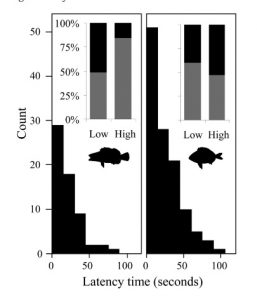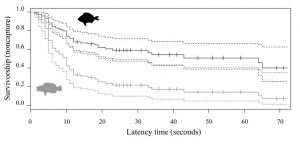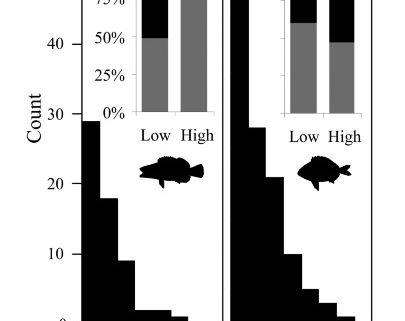Recreational angling intensity correlates with alteration of vulnerability to fishing in carnivorous coastal fish species
by Dani Escontrela, RJD intern
Fish behavior affects the vulnerability they have to fishing gear and therefore is a key player in determining and moderating the impacts of fishing on wild populations. In a theory known as the foraging arena theory it is explained that behavioral adaptation is driven by two main forces: predation risks caused by natural predators or by fishing. To avoid predation fish will cluster into two groups, one in which they are vulnerable or one in which they are invulnerable to predation. The decision to go into one of these groups will determine the proportion of fish that are vulnerable to fishing gear. There are two mechanisms that can affect the flow of fish from vulnerable to invulnerable pools in response to fishing gear. On the one hand there are evolutionary pressures in which the bolder fish were more often in the vulnerable pool and got taken out of the population by fishing due to their increased risk of being caught. On the other hand, fish could have acquired gear avoidance behaviors through individual or social learning. Either of these explanations leave behind individuals that are harder to catch therefore increasing the number of individuals in the invulnerable pools as fishing pressures increase.
The experiment set out to determine how species-specific behavioral responses to recreational angling gear altered the proportion of vulnerable and invulnerable pools in the wild with increasing fishing pressures. They used two fish species with different foraging ecologies to determine their vulnerability to recreational angling gear. They hypothesized that recreational angling, which is a human predation risk for fishes, causes a change in behavior which in turn causes the proportion of fish in the vulnerable and invulnerable pools to change. They used two fish species that share the same habitat but differ in their feeding ecology. The S. scriba is a carnivorous fish that feeds on mobile prey, making it more vulnerable to fishing, while the D. annularis is omnivorous and feeds on small, sessile prey, making it less vulnerable to fishing. The sampling site was off the coast of the Mediterranean along sea grass beds where these fish resided. The number of fishing vessels were counted at each study site and were an index of predation risk for the fish species. Meanwhile, video was used to record the fish’s behaviors when they were exposed to baited hooks. The latency time was recorded for an individual to ingest the bait on a baited hook; the baited hooks were then cut to void actual capture of the fish.

Histogram of latency time in seconds for S. scriba (left panel) and D. annularis (right panel). The inset panels show the proportion of captured (black) and non-captured (grey) in high and low intensity fishing environments for both fish species.
This experiment found a correlation between risk taking behaviors in relation to angling intensity for S. scriba, however no correlation was found for D. annularis. The experiment showed that some exploited fish species such as the S. scriba become less likely to take risks and therefore more invulnerable with increased fishing pressures. This migration of fish individuals from vulnerable to invulnerable pools may explain decreased catch rates and decreased fish abundance. This study found vulnerability to fishing to be substantially different in S. scriba that inhabited highly exploited sites compared with individuals in lower exploited areas. Three implications can be drawn from these results. First of all, the increased amount of fish species in invulnerable pools due to increased recreational fishing pressures can have implications for population dynamics, food web interactions, the productivity of the fishery and individual fitness. Second, assessing population abundance from hook-and-line-based catch may be unreliable since different fish species and populations have different behaviors therefore affecting how vulnerable they are to being caught. Finally, because behavior and life history traits are often correlated, one should be careful in regards to sampling bias caused by preferential capture of certain behavioral types.

Graph correlating latency time and survivorship (non-capture) for S. scriba (in gray) and D. annularis (in black). The solid lines show the survival distribution and the broken lines show the 95% confidence interval
Alós, Josep, Miquel Palmer, Pedro Trías, Carlos Díaz-Gil, and Robert Arlinghaus. “Recreational angling intensity correlates with alteration of vulnerability to fishing in a carnivorous coastal fish species.” Canadian Journal of Fisheries and Aquatic Sciences 72, no. 999 (2014): 1-9.




Leave a Reply
Want to join the discussion?Feel free to contribute!